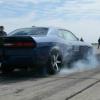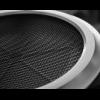Leaderboard
Popular Content
Showing content with the highest reputation on 04/07/2015 in all areas
-
There seems to be some consensus on the voltage requirements for electrostatic headphone amps. Nearly all of the commercially available designs put out between 1000 and 1600 volts peak-to-peak, a range of about 4 dB. The legendary Stax SRM-T2 was specified to put out a bit more, close to 1800 volts peak-to-peak, which is 1 dB higher. This would be equivalent to almost all loudspeaker amplifiers putting out between 50 and 125 watts, with the T2 being like a 160 watt amplifier. However, there hasn’t been much discussion on the current demands for electrostatic headphone amps. Output stage currents in commercial amplifiers have run between 2 mA/channel (Koss ES950) and 36 mA/channel (Blue Hawaii). Back in 1978, Nelson Pass published in The Audio Amateur (issue 4, p. 12) some measurements he had done on the slew rate of music signals. He tried out various cartridges and LP records, and using a 100 watt amplifier with a 30 volt/microsecond slew rate, reported that the highest slew rate he found with music signals was 1.5 volts/microsecond up to clipping levels. The late Peter Baxandall also published some years ago in Wireless World that music signals required an amplifier slew rate sufficient to drive a 6 kHz sine wave to clipping with low distortion, which works out to pretty much the same thing. A 100 watt amplifier has a peak-to-peak output of 80 volts. The Blue Hawaii, to take a current state of the art amplifier, has a peak-to-peak voltage at clipping of close to 1600 volts, which is 20 times higher, so the fastest music signal would have a slew rate of 30 volts/microsecond when the Blue Hawaii is driven to clipping. So how much current does an electrostatic headphone amp need to produce a slew rate of 30 volts/microsecond? A typical electrostatic headphone approximates a load of about 100 pf - Stax specifies most of their current models between 94 and 120 pf. The amount of current required for 30 volts/microsecond into 100 pf would be 3 mA. This is the amount of current that the amplifier has to supply to the headphones alone in order to play the fastest music signals up to clipping. Since amplifiers don’t sound their best at the very limits of their capability, for any real amplifier, there should be additional capacity in both slew rate and current over the bare minimum required. John Broskie has suggested on his TubeCAD website that for low distortion the maximum signal current demand on a tube be a fifth of the standing current. This calculation also assumes that the amplifier itself does not consume any signal current. But that is not always true. Take the Egmont, a basic, inexpensive tube electrostatic amp circuit. It uses 66k resistor loads in its output stage. With +/- 260 volt supplies the output stage runs at 7.9 mA current. If we drive the headphones to 1000 volts peak-to-peak using our fastest music signal the headphone consumes 1.9 mA, but the resistor consumes 7.6 mA, using all the current the output stage is theoretically capable of supplying. The reason that an amp with a total current of 7.9 mA can supply both 1.9 mA to the phones and 7.6 mA to the resistor loads is that the current to the headphone is approximately 90 degrees out of phase with the current to the resistors – remember the geometry of a right angled triangle? The headphone and resistor compete for the available current, and since the resistor is lower impedance than the headphone, the resistor hogs most of the current and the headphone is left with the scraps. Furthermore, the amount of signal current soaked up by the resistor depends on the magnitude of the signal, whereas the amount of current going to the headphones depends on the speed of the signal, so the ratio of 1.9 mA to the phones and 7.6 mA to the resistor is even worse almost all of the time. In fact, this is a problem for any electrostatic headphone amp that uses resistor loads in the output stage since the resistor sets both the standing voltage and the standing current. Massively increasing the voltage and current so that no user will ever come close to reaching its limits doesn’t really solve the problem, it just pushes it farther away. And then, a further problem is that devices and components which can withstand that amount of voltage, current and power are expensive, which rather defeats the goal of an inexpensive design. Now, take my revision of the Stax SRX tube design using current loads. The output stage runs at a higher current and voltage: 14 mA current with the power supplies run at +/- 325 volts. More importantly, the cascoded current loads on each plate measure over 160 megohms impedance, thus requiring a mere 4 microamps to drive them to clipping, so 99.9% of the total standing current is available to drive the headphones. The maximum current required to drive the headphones at clipping is about 2.4 mA, less than a fifth of the current available. To further illustrate the value of a good current source, let’s go back to the Egmont. With the output tubes in that design delivering the same peak signal current of 2.4 mA, it would produce about 300 volts peak-to-peak with about 2.3 mA going to drive the resistors and 0.6 mA to the headphones. For the same signal voltage into the headphones, the Egmont output tubes have to produce 4 times as much signal current. Now these are “back of the envelope” calculations. But at least, now we have a reasonable estimate of how much signal current an electrostatic headphone needs to faithfully reproduce the fastest music signals. And, it is clear that replacing resistor loads with current sources is a much more efficient method. Finally, let me make a brief comment about a related matter. It is sometimes said that electrostatic headphones require voltage but no power. This is false. It is true that electrostatic headphones resemble capacitors, and with a capacitor, the drive voltage and current are 90 degrees out of phase so that no power is consumed. However, remember that a capacitor is a simplified model of a stat headphone. In fact, electrostatic headphones have to consume energy, because we can hear the sound they produce! Sound is a form of energy, and by the law of conservation of energy, one of the most fundamental laws of physics, that means the headphones have to consume energy.5 points
-
3 points
-
Billie Holiday - Last Recording Today is the 100th anniversary of Lady Day's birth. This is arguably not one of her bests but is deeply emotional, recorded a few days before her passing away. Personnel: Billie Holiday, vocals Ray Ellis, arranger & conductor Harry Edison, trumpet Joe Wilder, trumpet Billy Byers, trombone Al Cohn, tenor sax Danny Bank, baritone sax Hank Jones, piano Barry Galbraith, guitar Milt Hinton, bass Osie Johnson, drums2 points
-
Curling. Sweden vs. Norway for the final in the Men's World Championship. Because I love Debbie.2 points
-
1 point
-
xianghao, It would be great if you posted your thoughts on A/B'g different tubes. Best of luck and I hope you have some fun with it. HS1 point
-
Maybe i should not interrupt.......... collecting different 6s4a and waiting to do AB test...... if somesone is intersting about the result, i will do a summary...1 point
-
yep in fact you can delete a number of the parts. 2 sets of RCRC and then a jumper on the C to ground.1 point
-
1 point
-
1 point
-
How about I ruck the metric with a 30 pound pack, assuming my back and shoulder cooperate. The idea of getting on a bike again is not appealing at all but would consider riding Sebring Labor Day, if no family stuff going on.1 point
-
I'm pretty sure I'm legally required to watch them all, I'm surprised no-one (neither online nor in-real-life) has called me on that.1 point
-
Yah, I'm sure the record that single-handedly launched his career and put him on the map as one of the great interpreters of the 20th century is just a calisthenics exercise hardly worth listening to.1 point
-
1 point
-
1 point











